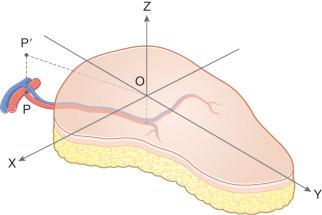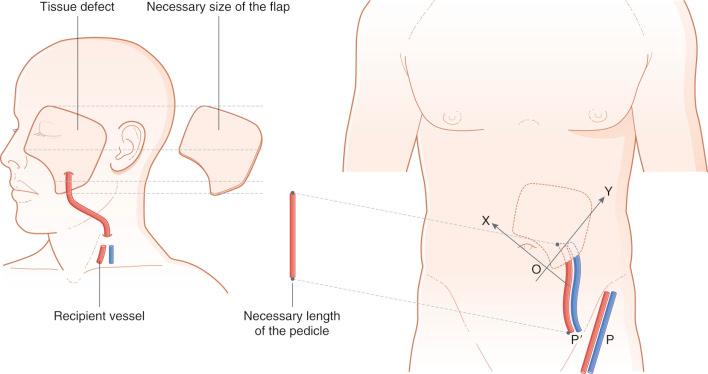Physical Address
304 North Cardinal St.
Dorchester Center, MA 02124
The purposes of flap transfer are classified into four categories: surface coverage; volume restoration; framework creation; and functional reconstruction. Category one is surface coverage of the defect without the need for significant thickness. In clinical situations, since every flap has some degree of thickness, surface coverage inevitably is associated with provision of volume (category two). The third category is reconstruction of a framework . Transfer of vascularized bone, such as the iliac bone or fibula, is classified into this category. The fourth category is functional reconstruction , aiming to restore defective function. Muscle flap transfer for reanimation of the face and vascularized nerve flap transfer are examples of this category.
In this chapter, the first, second, and third categories of flap transfer, especially in relation to free flap transfer, are described, with a focus on adaptation of the shape to the needs of the recipient defect.
From a geometric viewpoint, the flap can be regarded as a 3-dimensional model specified by the XYZ coordinates ( Fig. 26.1 ). Each axis corresponds to the specific properties of the flaps for clinical use. The origin O indicates the surface projection point of the vascular pedicle entry point to the flap mass, and the XY plane coincides with the surface of the skin flap. In the XY plane, the Y-axis represents the direction of approximate axiality of the flap circulation. The Z-axis characterizes the thickness of the skin flap. Point P corresponds to the branching point of the pedicle vessel of the flap from the main vessel and is usually found deep to the XY plane. Point P′ is the projection of point P to the XY plane. The distance between points P′ and O denotes the approximate length of the vascular pedicle of the flap.

Clinically, the vascular pedicle of the flap will contract after elevation and separation of the flap from the donor site. Since anastomosis between the recipient and donor vessel should be performed without tension, it is preferable to underestimate the potential length of the pedicle. Therefore, the distance P′O, which is actually shorter than the length of the pedicle that is harvested, represents the approximate clinical value.
In summary, the morphologic features of the flap can be described by 3-dimensional variables (X, Y, Z) as well as the distance and direction of P′O.
The first step in flap surgery is to evaluate which categories of reconstruction, surface, volume, framework, or function are required for the specific defect. For example, breast reconstruction requires considerable volume as well as surface coverage, whereas reconstruction for a burn scar contracture of the neck needs surface coverage with minimal volume, and a craniomaxillofacial defect frequently requires some skeletal framework with volume reconstruction.
The second step is to choose the recipient vessels to be anastomosed easily and safely, and estimate the required length of the flap's pedicle vessel. Since the maximum length of the pedicle vessel for each specific flap to be harvested is nearly constant, flap selection should take this important criterion into consideration.
The third step is to assess the match in color and texture of the flap and the recipient site, and to balance the outcomes that can be anticipated at the recipient site with the morbidity that will be created at the donor site.
The donor site for the flap is selected after consideration of these detailed requirements for reconstruction. Once the donor site for flap transfer has been decided, the position of point O, which is detected using the Doppler flowmeter or estimated from the anatomic surface landmarks, is marked on the donor skin. In addition, the X and Y axes are marked across point O with reference to the approximate axiality of the blood flow in the skin, which is usually parallel to the major axis on the extremities and to the direction of the ribs on the back and the chest wall, radiating from the umbilicus on the abdomen, and radiating from the femoral triangle in the inguinal area.
The location of point P is predicted from the palpable point of the major arteries from the surface and point P′ is also marked on the XY plane of the donor skin. For example, the axillary artery gives off the subscapular artery that provides blood supply to the scapular flap and the thoracodorsal artery that provides blood supply to the latissimus dorsi myocutaneous flap; the femoral artery gives off branches such as the superficial circumflex iliac artery that supplies the groin flap, and the deep femoral artery and the lateral circumflex femoral artery that supply the anterolateral thigh flap. Furthermore, the origin of the deep inferior epigastric artery that supplies the rectus abdominis muscle is from the femoral artery; and the popliteal artery gives off the peroneal artery nourishing the fibula ( Fig. 26.2 ).

Tailoring of the flap begins by deciding on the outline of the flap to be elevated in the X, Y, Z coordinates of the donor site by projecting the 3-dimensional relationship between the recipient defect and the relative position of the recipient vessels. If the recipient defect requires a flap with a folded structure, such as reconstruction for an oropalatolaryngeal defect, development of the structure is similarly projected to the donor site. For a successful transfer of the flap, the flap's pedicle vessels must be kept in a natural position after transfer to the recipient bed. Tension and twisting of the anastomosed vessel should be strictly avoided.
Therefore, the 3-dimensional relationship is projected so as to adjust the expected position for anastomosis to the recipient vessel at point P. At the same time, vector OP′ should be positioned in nearly the same direction as the venous flow in the recipient vessel. As a result, the coordinates of the outline of the flap are determined. Arrangement of the recipient and donor vessels is an essential component of microsurgical tissue transfer ( Fig. 26.3 ). In particular, incorrectly arranged veins tend to kink and disrupt the outflow of blood following revascularization of the flap.

Furthermore, it is preferable to adjust the major length of the defect to the Y-axis on the donor site, especially in the case of a large flap. If the recipient requirement obviously exceeds the surviving area based on one axial vessel, combining a neighboring region of tissue based on another axial vessel is advisable.
Become a Clinical Tree membership for Full access and enjoy Unlimited articles
If you are a member. Log in here